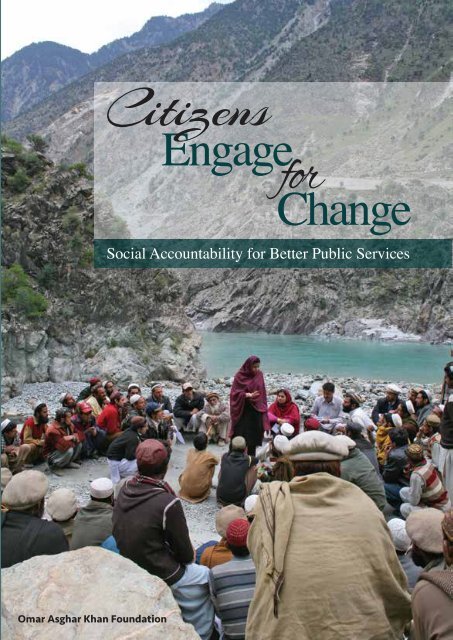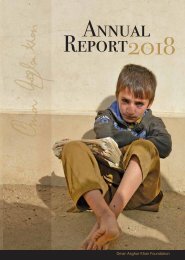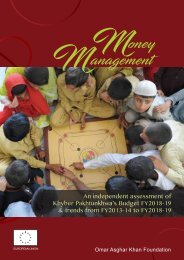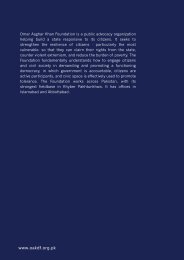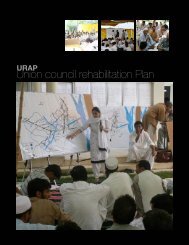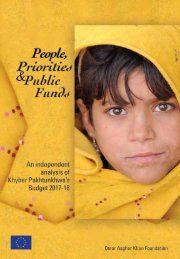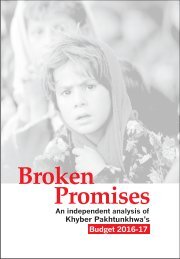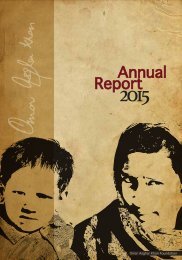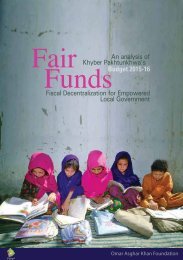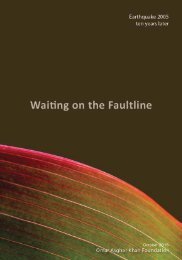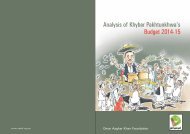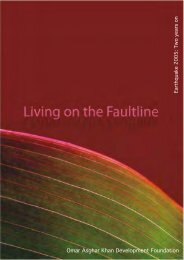Citizen Engage for Change
You also want an ePaper? Increase the reach of your titles
YUMPU automatically turns print PDFs into web optimized ePapers that Google loves.
<strong>Citizen</strong>s<br />
<strong>Engage</strong><br />
<strong>for</strong><br />
<strong>Change</strong><br />
Social Accountability <strong>for</strong> Better Public Services<br />
Omar Asghar Khan Foundation
Published by Omar Asghar Khan Foundation<br />
January 2017<br />
Lay-out and printing by Sense Communications Pvt. Ltd.<br />
This publication was made possible with financial assistance by Open Society Institute.<br />
Its support is gratefully acknowledged.<br />
Omar Asghar Khan Foundation<br />
Established in 1999, Omar Asghar Khan Foundation is creating<br />
opportunities <strong>for</strong> people, particularly the vulnerable, to collectively<br />
secure human and livelihood rights by strengthening their asset base<br />
and making Institutions and policies pro-poor. The foundation’s<br />
field-based work is primarily in Khyber Pakhtunkhwa. Its advocacy has<br />
a national focus. The Foundation has offices in Islamabad and<br />
Abbottabad.
<strong>Citizen</strong>s<br />
<strong>Engage</strong><br />
<strong>for</strong><br />
<strong>Change</strong><br />
Social Accountability <strong>for</strong> Better Public Services
Never doubt that a small group of<br />
thoughtful, committed citizens can<br />
change the world. Indeed, it is the<br />
only thing that ever has.<br />
Margaret Mead
Contents<br />
1. Introduction<br />
2. Case Studies on Social Accountability<br />
District Kohistan<br />
Operationalizing a THQ<br />
tracking budgets <strong>for</strong> equipment/staff & working with the media<br />
Reconstructing a road destroyed by the 2010 floods<br />
using the RTI to access government documents<br />
District Abbottabad<br />
Improving tertiary-care facility<br />
holding governments to account on their pledges<br />
Upgrading rural healthcare<br />
tracking budgets <strong>for</strong> equipment/staff & building political support<br />
District Battagram<br />
Reconstructing schools destroyed by the 2005 earthquake<br />
sustained advocacy with multiple stakeholders<br />
3. Conclusions
Acronyms<br />
ANP<br />
BHU<br />
C&W<br />
CM<br />
CNIC<br />
DHO<br />
DHQ<br />
EDO<br />
ERRA<br />
HFA<br />
KKH<br />
KP<br />
MPA<br />
NGO<br />
PC-1<br />
P&D<br />
PTI<br />
RHC<br />
RTI<br />
THQ<br />
UC<br />
UHAP<br />
VC<br />
Awami National Party<br />
Basic Health Unit<br />
Communications & Works<br />
Chief Minister<br />
Computerized National Identity Card<br />
District Health Officer<br />
District Headquarter (hospital)<br />
Executive District Officer<br />
Earthquake Reconstruction & Rehabilitation Authority<br />
Health Facility Assessment<br />
Karakorum Highway<br />
Khyber Pakhtunkhwa<br />
Member of Provincial Assembly<br />
Non Governmental Organization<br />
Planning Commission-1 (a government project document)<br />
Planning & Development<br />
Pakistan Tehreek-e-Insaf<br />
Rural Health Center<br />
Right to In<strong>for</strong>mation<br />
Tehsil Headquarter (hospital)<br />
Union Council<br />
Union Council Health Action Plan<br />
Village Council
1. Introduction<br />
<strong>Citizen</strong>s have a right to access quality basic<br />
services and participate in democratic<br />
processes. For over a decade Omar Asghar<br />
Khan Foundation is helping citizens to<br />
know and claim this right. It assists them to<br />
be more in<strong>for</strong>med, skilled, organized and<br />
confident in engaging with elected and<br />
non-elected duty-bearers, to stimulate<br />
public demand, and, to put pressure on the<br />
government to deliver quality services.<br />
The Foundation also helps strengthen the<br />
supply side of the governance equation by<br />
assisting public representatives and<br />
government officials to be more responsive<br />
to citizens.<br />
The Foundation’s strong commitment to<br />
equity is reflected in the priority it places on<br />
working with and <strong>for</strong> marginalized groups<br />
like the poor, women and the youth.<br />
Since 2013 the Foundation has adapted and<br />
intensified its strategies in Khyber<br />
Pakhtunkhwa to benefit from opportunities<br />
<strong>for</strong> citizen-government interaction<br />
provided by the local government set up in<br />
2015, and, by enabling laws like the Right to<br />
In<strong>for</strong>mation Act 2013 and the Right to<br />
Public Services Act 2014. Among the<br />
Foundation’s repertoire of interventions is<br />
the promotion of citizen monitoring to<br />
increase downward accountability and<br />
responsiveness of public services to<br />
citizens, especially the more marginalized.<br />
The Foundation designs and delivers<br />
tailor-made training <strong>for</strong> civil society<br />
organizations helping them to become<br />
familiar with social accountability and learn<br />
its different methodologies. It also assists<br />
trained civil society organizations in<br />
applying social accountability skills to<br />
monitor the government’s per<strong>for</strong>mance<br />
and hold it to account. It helps citizens and<br />
duty-bearers better understand and benefit<br />
from the advantages of working together to<br />
achieve improved public service delivery<br />
and better development outcomes.<br />
Using participatory methodologies to support citizen monitoring in some of the poorest areas of KP<br />
1
This publication documents the<br />
Foundation’s experiences of supporting<br />
social accountability in some of the poorest<br />
parts of Khyber Pakhtunkhwa’s Hazara<br />
region -- in the districts of Kohistan,<br />
Battagram and Abbottabad. It presents five<br />
case studies on civil society engagement<br />
with government <strong>for</strong> improving healthcare<br />
and access to schools, and, reducing the<br />
isolation of the very poor living in remote<br />
mountains. The case studies, categorized by<br />
district, give details of how civil society<br />
organizations, assisted by the Foundation,<br />
identified public grievances, developed<br />
social accountability strategies, gathered<br />
valid data, and, engaged with the<br />
government to address their problems.<br />
Beyond generating evidence-based<br />
demands <strong>for</strong> changing the conditions of<br />
public facilities, the case studies show how<br />
social accountability is making civil society<br />
organizations more vibrant and<br />
knowledgeable, capable of strategizing,<br />
analyzing and organizing. It is helping<br />
citizens become more familiar with their<br />
right to demand quality services and the<br />
responsibility of the government to deliver<br />
them. <strong>Citizen</strong>s are more aware of ways to<br />
access in<strong>for</strong>mation about government<br />
activities and decisions, the skills to<br />
evaluate their impact, and the will to<br />
engage in governance to change their lives.<br />
2
2. Case studies on Social<br />
Accountability<br />
District Kohistan<br />
Three phenomenal mountain systems:<br />
Hindukush, Himalaya and the Karakorum<br />
meet in Kohistan, explaining its name<br />
which means the land of mountains. The<br />
magnificent River Indus meanders through<br />
the district’s tough rocky terrain spread<br />
across 7,492 sq km 1 . According to a 2011<br />
assessment, Kohistan is the most deprived<br />
district of the province, with about 70 per<br />
cent of its population without adequate<br />
health, education and other facilities 2 .<br />
Behind these statistics are lives that are<br />
desperately poor. An estimated 470,000<br />
people 3 , living in small villages scattered<br />
across imposing mountains, survive on<br />
minimal subsistence agriculture and<br />
off-farm uncertain income. Timber in the<br />
area has high profits but is controlled by<br />
just a handful. Many ancient tribal customs<br />
cause insecurity, worsened by more recent<br />
trends in militancy.<br />
Chronic poverty in Kohistan is compounded<br />
by high vulnerability to natural disasters,<br />
which is escalating as climate changes<br />
unfold. Affected people have little time to<br />
cope be<strong>for</strong>e the next emergency strikes. The<br />
past ten years, or so, are illustrative. The<br />
area and its people suffered a devastating<br />
earthquake in 2005, militancy since 2007,<br />
massive floods in 2010 and another<br />
earthquake in 2015.<br />
Women, children and the elderly are more<br />
vulnerable to this virulent mix of complex<br />
challenges. Severe restrictions on their<br />
mobility makes it hard <strong>for</strong> them to access<br />
the painfully limited essential services<br />
available, impoverishing them further.<br />
1 Pakistan Bureau of Statistics, (2006), Government of Pakistan<br />
2 Haroon Jamal, (2012), Districts’ Indices of Multiple Deprivations <strong>for</strong> Pakistan 2011, Social Policy & Development Center<br />
3 Pakistan Bureau of Statistics, (2006), Government of Pakistan<br />
3
4<br />
THQ complex in Pattan, January 2015
District Kohistan<br />
Operationalizing a THQ<br />
tracking budgets <strong>for</strong> equipment/staff &<br />
working with the media<br />
Kohistan has three Rural Health Centers<br />
(RHCs) and 37 Basic Health Units (BHUs). It<br />
does not have a District Headquarter<br />
Hospital (DHQ).<br />
In 2007, the government constructed an<br />
imposing structure <strong>for</strong> a Tehsil Headquarter<br />
Hospital (THQ) which was to replace the<br />
small RHC in Tehsil Pattan. The Omar<br />
Asghar Khan Foundation came across this<br />
THQ in 2010 while it was providing relief<br />
assistance to people affected by the<br />
devastating floods that swept through<br />
Kohistan’s valleys.<br />
Women Medical Officer was not<br />
available at any of the surveyed RHCs.<br />
Health Facility Assessment of District Kohistan<br />
2012<br />
The THQ complex was like an oasis in a<br />
parched desert. But its 100-bed capacity,<br />
operating theater, emergency care, and,<br />
doctors’ residence were hauntingly empty –<br />
there was no staff, equipment, medicines,<br />
furniture or essential utility connections.<br />
Signs of neglect were everywhere, except a<br />
shiny plaque on the entrance announcing<br />
its opening on 1st February 2007 by an MPA.<br />
Plaque announcing the THQ’s inaugural in 2007<br />
Inside the <strong>for</strong>saken THQ<br />
5
The Foundation and its partners in Kohistan<br />
decided to push <strong>for</strong> operationalizing this<br />
oversized white elephant sprawled on the<br />
bank of River Indus. They started by<br />
tracking Khyber Pakhtunkhwa’s budgets<br />
since FY2010-11 to assess if funds were<br />
provided <strong>for</strong> equipment and other<br />
requirements <strong>for</strong> a functional THQ.<br />
Funds <strong>for</strong> THQ Pattan (P.Rs. in Millions)<br />
KP Budget FY Allocation Expenditure<br />
2011-12<br />
83.22 52.38<br />
2012-13<br />
2013-14<br />
2014-15<br />
2015-16<br />
2016-17<br />
21.33<br />
21.41<br />
21.41<br />
-<br />
62.15<br />
-<br />
-<br />
-<br />
-<br />
TBC<br />
The assessment confirmed that funds were<br />
allocated each year since FY2011-12 but<br />
remained unused apart from Rs.52.38<br />
million spent in FY2011-12. The THQ<br />
remained <strong>for</strong>saken. The local healthcare<br />
staff continued to function out of the RHC<br />
at Pattan. The case of Pattan’s THQ was<br />
presented in public meetings, press<br />
conferences and in discussions with<br />
parliamentarians, political leaders and<br />
government officials. Trained local activists<br />
kept a watch on the THQ <strong>for</strong> signs of activity.<br />
<strong>Citizen</strong>s monitoring the incomplete THQ<br />
6
Sustained public pressure prompted action.<br />
In 2015, the debris in the THQ was cleared,<br />
electrification was completed, and, the<br />
entire complex was cleaned and<br />
whitewashed. Yet, it remained<br />
non-functional, unequipped to serve people<br />
even when they desperately needed<br />
emergency assistance after an earthquake<br />
in October 2015 killed and injured many,<br />
and, a few months later incessant rains in<br />
early 2016 swept away homes and<br />
destroyed infrastructure.<br />
The Foundation collaborated with Geo TV<br />
to project the miseries of the Kohistani<br />
people in its primetime TV show, Naya<br />
Pakistan, hosted by the popular Syed Talat<br />
Hussain. The show included a detailed<br />
report on the THQ, exposing the cruel irony<br />
presented by its bare rooms and<br />
whitewashed corridors at a time when the<br />
district’s poor desperately needed<br />
healthcare. Shortly after the show was<br />
telecast in April 2016, local activists<br />
monitoring the THQ reported that the DHO<br />
visited the facility. And on 8 October 2016 –<br />
on the eleventh anniversary of the 2005<br />
earthquake – Chief Minister Pervez Khattak<br />
inaugurated an equipped THQ.<br />
CM Pervez Khattak inaugurating the THQ<br />
Syed Talat Hussain, Naya Pakistan on Geo TV<br />
7
Determined ef<strong>for</strong>ts of the people of<br />
Kohistan, supported by the Foundation,<br />
resulted in operationalizing the THQ, nine<br />
years after it was constructed. The analysis<br />
of Khyber Pakhtunkhwa’s budgets provided<br />
data on unutilized allocations which<br />
supported public queries on the<br />
government’s failure to equip and staff the<br />
THQ despite available public funds. Regular<br />
on-the-ground monitoring helped report<br />
activity, if any, at the facility level. The<br />
Foundation and its local partners used the<br />
evidence to engage a wide-range of<br />
stakeholders to push <strong>for</strong> government action<br />
to make the THQ functional. An important<br />
game-changer was the popular TV show<br />
that put the spotlight on the THQ at a time<br />
when rains had drawn public attention to<br />
Kohistan’s deprivation.<br />
It is uplifting to see the THQ finally<br />
operational, helping serve the healthcare<br />
needs of people in the province’s poorest<br />
district. The sustained advocacy has paid<br />
off. But more work is needed as the THQ is<br />
still just partially functional. Local trained<br />
citizen groups in Kohistan, skilled and more<br />
confident after their initial success, are<br />
maintaining public pressure. Their demand<br />
<strong>for</strong> government action to make the THQ<br />
fully functional, echoes hope through the<br />
valleys of Kohistan.<br />
8
District Kohistan<br />
Reconstructing a road destroyed by the<br />
2010 floods<br />
using the RTI to access government<br />
documents<br />
Kandia, one of Kohistan’s 14 valleys, was<br />
severely affected by the catastrophic 2010<br />
floods. Hundreds in the estimated 90km<br />
long valley fled their homes as the mighty<br />
Indus continued to swell, eventually leaving<br />
a watermark about 30 feet higher than<br />
normal levels. Many in Kandia were<br />
stranded as more than half of the 70km<br />
road connecting them with the Karakorum<br />
Highway was washed away.<br />
As floodwaters began to recede, they<br />
clambered down the mountains in search of<br />
food. The first to provide them with relief<br />
assistance was Omar Asghar Khan<br />
Foundation. Its teams scaled the Babusar<br />
Top at 4,173m and crossed Chilas to reach<br />
Kandia as the regular route via Dassu was<br />
inaccessible due to bridges swept away by<br />
the floods. This was the beginning of an<br />
enduring partnership between the people<br />
of this very poor valley and the Foundation.<br />
The Foundation’s Ms. Rashida Dohad with Kandia’s flood-affected people, 2010<br />
9
After the relief phase, the Foundation and<br />
its Kandia partners turned their attention<br />
to rehabilitation. Reconstructing the<br />
damaged Kandia road was given high<br />
priority as it links the valley’s people to their<br />
lifeline: the Karakorum Highway or KKH as<br />
it is popularly known. Built in 1966 the KKH<br />
connects the mountainous people to food,<br />
jobs, and, healthcare. Working together,<br />
the Foundation and local people cleared<br />
and repaired the road, succeeding in making<br />
it jeepable. But its proper rehabilitation was<br />
required. The people in Kandia decided to<br />
build public demand <strong>for</strong> the reconstruction<br />
of their road.<br />
In the first half of 2013 a series of<br />
consultative meetings were held in the<br />
valley. More people joined the campaign <strong>for</strong><br />
the road. They contacted the local<br />
administration and also met with public<br />
representatives inquiring about<br />
government plans to rebuild the Kandia<br />
road. But they were not given a clear<br />
response.<br />
The Foundation’s analysis of Khyber<br />
Pakhtunkhwa’s budget FY2011-12 identified<br />
Rs.4.3 million allocated <strong>for</strong> studying the<br />
feasibility of reconstructing the Kandia<br />
road. This amount appeared expended in<br />
FY2012-13. The analysis of subsequent<br />
budgets did not show any allocation <strong>for</strong><br />
rebuilding the road. It become imperative<br />
to access and review the feasibility report<br />
and its recommendations.<br />
10
On 31 October 2013 Khyber Pakhtunkhwa’s Right to In<strong>for</strong>mation law was passed, giving<br />
unprecedented public access to government documents. The Foundation assisted its<br />
partners in Kohistan to use the RTI to access the feasibiity report.<br />
May<br />
Request <strong>for</strong> a copy of the<br />
feasibility sent to local<br />
government departments<br />
January<br />
August<br />
Request <strong>for</strong> the report<br />
sent to P&D<br />
Complaint lodged with RTI<br />
January<br />
CNIC sent<br />
2<br />
0<br />
1<br />
4<br />
2<br />
0<br />
1<br />
5<br />
May<br />
Local departments claim<br />
they neither have info<br />
on the feasibility nor funds<br />
<strong>for</strong> reconstruction<br />
No response received<br />
January<br />
RTI Commission requests CNIC<br />
Febuary<br />
RTI Commission asks C&W to<br />
respond to citizen request<br />
May<br />
The Foundation requests RTI<br />
Commission to help access the<br />
elusive report<br />
June<br />
June<br />
Fresh request sent to<br />
C&W Department<br />
Complaint filed after 20 days, as<br />
no response received<br />
August<br />
Email sent to C&W regarding<br />
non-receipt of attachment<br />
July<br />
The Foundation offers to<br />
pay photocopying charges<br />
2<br />
0<br />
1<br />
6<br />
Trail goes cold again<br />
June<br />
Fresh request asked by RTI<br />
Commission -- no info on<br />
previous request or complaint<br />
July<br />
Email from C&W states<br />
the report is 800+ pages<br />
August<br />
Cover letter received from C&W<br />
- without the attached report<br />
No response received<br />
11
Khyber Pakhtunkhwa<br />
Right to In<strong>for</strong>mation<br />
identify the info<br />
you need<br />
send a written request<br />
clearly identifying the<br />
in<strong>for</strong>mation needed to the<br />
relevant department<br />
to show that you<br />
are a citizen of<br />
Pakistan include<br />
a copy of your CNIC<br />
complaints may be sent to if you are not satisfied<br />
RTI Commission<br />
with the response to<br />
Government of Khyber your request, you<br />
Pakhtunkhwa<br />
may send a written<br />
7th Floor, Tasneem Plaza complaint<br />
6th Saddar Road<br />
Peshawar Cantt<br />
Fax: + 92 - 91 - 9211163<br />
Email: complaints@kprti.gov.pk<br />
you should<br />
receive the<br />
in<strong>for</strong>mation or a<br />
response as soon<br />
as possible<br />
within 10 or a max<br />
of 20 working days<br />
www.kprti.gov.pk Toll Free # 0800 - 57784<br />
12
People of Kohistan demand better government per<strong>for</strong>mance<br />
The two-year chase was frustrating, but not<br />
completely futile. The feasibility report is<br />
still out of public reach. But the Foundation<br />
and its partners in Kohistan successfully<br />
kept a spotlight on the damaged road. They<br />
brought local people together to demand<br />
its reconstruction. They became more<br />
familiar with the RTI and its mechanism <strong>for</strong><br />
accessing government documents, which<br />
they have used with better results to get<br />
other documents.<br />
Local people connected by the advocacy <strong>for</strong><br />
reconstructing the road are still working<br />
together. When rains in 2016 caused more<br />
damage to the Kandia road, they picked up<br />
their shovels and cleared it, refusing to<br />
remain isolated or affected by government<br />
inattention. They continue to use their<br />
social accountability knowledge and<br />
experience to knock on doors, to demand<br />
better government response on their need<br />
<strong>for</strong> road reconstruction and other facilities.<br />
They are engaging with the government on<br />
public hopes and fears stirred by the<br />
planned hydropower projects near Kandia,<br />
and discussing the possibility of making the<br />
rebuilding of their road a part of the<br />
construction work.<br />
13
14<br />
District Abbottabad
District Abbottabad<br />
One of six districts of the Hazara region,<br />
Abbottabad is named after its founder<br />
Major James Abbott who served as Hazara’s<br />
first Deputy Commissioner from 1849 to<br />
1853. More than 80 per cent of its present<br />
population of about 880,000 lives in<br />
villages spread across 1,967 sq km of its<br />
picturesque, largely mountainous terrain.<br />
Its principal city, Abbottabad, at 1,256m<br />
above sea level and about 150km from<br />
Islamabad is a hub <strong>for</strong> large numbers of<br />
tourists from within and outside the<br />
country, especially in the summer 5 .<br />
In 2010-11 Abbottabad’s District<br />
Headquarter (DHQ) hospital, five Civil<br />
Hospitals, four Rural Health Centers (RHC)<br />
and 11 of its total 56 Basic Health Units<br />
(BHU) were surveyed as part of a health<br />
facility assessment (HFA). The HFA<br />
reviewed the availability, functioning, and<br />
quality of Khyber Pakhtunkhwa’s public<br />
healthcare services, with a focus on<br />
maternal and child health.<br />
The HFA found the facilities in Abbottabad<br />
were short on equipment; in<strong>for</strong>mation on<br />
tracer drugs, supplies, vaccines and family<br />
planning items; and, inputs <strong>for</strong> infection<br />
control practices. It stated that buildings of<br />
all facilities required improvement and<br />
renovation 7 .<br />
RHCs<br />
BHUs<br />
DHQ<br />
THQ<br />
17<br />
20<br />
21<br />
25<br />
Ranking of facilities surveyed in KP’s 25 districts placed Abbottabad’s RHCs at 17,<br />
its BHUs at 20, its DHQ at 21 and at the bottom on 25 was its THQ<br />
5<br />
Pakistan Bureau of Statistics, (2006), Government of Pakistan<br />
6<br />
TRF-Technical Resource Facility, (2012), Health Facility Assessment-District Abbottabad, Government of KP<br />
15
16<br />
Abbottabad’s DHQ (above) and the<br />
medical ward to be razed to the ground (left)
District Abbottabad<br />
Improving tertiary-care facility<br />
holding governments to account on their<br />
pledges<br />
The DHQ in Abbottabad city serves as an<br />
important source of secondary-level<br />
healthcare <strong>for</strong> people from this district and<br />
also from its surrounding areas. A PC-1<br />
(government document prepared <strong>for</strong> each<br />
project) to upgrade its facilities was<br />
approved in 2012 by the outgoing ANP<br />
(Awami National Party) government.<br />
Rs.242.56 million was its estimated cost,<br />
and it was expected to be completed by<br />
2016.<br />
In 2013 the PTI (Pakistan Tehreek-e-Insaf)<br />
government took office. In his first visit to<br />
Abbottabad in January 2014 Chief Minister<br />
Pervez Khattak promised to complete the<br />
DHQ’s upgradation on a war footing.<br />
Similar public assurances were regularly<br />
echoed by senior ministers of his cabinet.<br />
The Foundation’s analysis of Khyber<br />
Pakhtunkhwa’s budgets showed that funds<br />
<strong>for</strong> the upgradation were allocated in<br />
FY2013-14 and FY2014-15 but remained<br />
unused. In 2014, a government notification<br />
called <strong>for</strong> submitting a revised PC-1.<br />
FY<br />
Allocations<br />
2013-14 Rs.5 million<br />
2014-15<br />
Rs.20 million<br />
2015-16<br />
Rs.30 million<br />
2016-17<br />
Rs.1,000<br />
The new PC-1, approved in 2015, shows a<br />
decreased total estimated cost of Rs.231.58<br />
million. Subsequently, Rs.30 million<br />
allocated in the province’s budget <strong>for</strong><br />
FY2015-16 was also not used.<br />
<strong>Citizen</strong> monitoring of the DHQ confirms<br />
that despite budget allocations and two<br />
approved PC-1s, no work has started on the<br />
ground. The old medical ward which was to<br />
be razed to the ground continues to stand in<br />
the DHQ complex. The new building to be<br />
constructed in its place <strong>for</strong> accommodating<br />
additional facilities remains a plan on paper.<br />
The budget in<strong>for</strong>mation and other evidences<br />
were provided to local journalists following<br />
this project. They used it to question senior<br />
government representatives. While<br />
reassurances were continually given, the<br />
budget of FY2016-17 shows an embarrassing<br />
amount of Rs.1,000 <strong>for</strong> the upgradation.<br />
17
This social accountability initiative has<br />
yielded important results. Public demands<br />
<strong>for</strong> fulfillment of promises made by the<br />
government are more strident. <strong>Citizen</strong><br />
groups have gained valuable experience in<br />
evidence-based public advocacy. They better<br />
understand the importance of government<br />
documents like the PC-1 and are more<br />
familiar with ways of using the RTI law to<br />
access them. They have learnt how to track<br />
funds in provincial budgets -- allocated or<br />
expended <strong>for</strong> approved projects. They are<br />
working closely with the media and others,<br />
acknowledging the power of partnerships.<br />
They continue to pursue the DHQ’s<br />
upgradation, determined to hold the<br />
government to account on its pledges.<br />
<strong>Citizen</strong>s making a difference<br />
18
District Abbottabad<br />
Upgrading rural healthcare<br />
tracking budgets <strong>for</strong> equipment/staff &<br />
building political support<br />
The Rural Health Center in Lora 7 serves<br />
people living in about 30 VCs (Village<br />
Councils) of District Abbottabad. It was<br />
inaugurated in 1963. Its upgradation to a<br />
D-Type Hospital was approved in 2008. But<br />
the upgradation was moving at a glacial<br />
pace.<br />
The Uhap was used to engage the<br />
government at the local level. Public<br />
demands <strong>for</strong> expediting the RHC’s<br />
upgradation was communicated to the<br />
EDO Health and other government officials.<br />
Public demands <strong>for</strong> its prompt completion<br />
was included in the Union Council Health<br />
Action Plan (Uhap) made by local people<br />
with the Foundation’s support in 2010-13.<br />
The Uhap is a citizen charter of demands <strong>for</strong><br />
better healthcare defined and validated<br />
through iterative public consultations using<br />
data collected through:<br />
• A public perception survey of<br />
government health facilities conducted in<br />
seven villages (267 female and 156 male<br />
respondents).<br />
• Village health action plans (Vhaps)<br />
prepared in two villages using participatory<br />
dialogue techniques.<br />
• Five oral testimonies conducted of<br />
women who had experienced obstetric<br />
emergencies.<br />
• An assessment of allocations <strong>for</strong> health in<br />
Khyber Pakhtunkhwa’s budgets <strong>for</strong><br />
FY2011-12 and FY2012-13.<br />
Discussing the Uhap with EDO Health in Abbottabad<br />
By 2013 the construction work <strong>for</strong> the<br />
upgraded RHC was completed. But it was<br />
not yet functional as it needed additional<br />
equipment and staff. Continued public<br />
pressure was maintained. Between 2014-16,<br />
equipment and staff also gradually trickled<br />
in. The RHC is now a D-Type hospital.<br />
Consistent citizen monitoring and<br />
engagement helped push the upgradation<br />
that was approved in 2008. Many<br />
contributed to this success, a key champion<br />
among them was Ms. Shiraz Iqbal.<br />
7<br />
Former Union Council which ceased to be an administrative unit in 2013 after the passage of<br />
KP’s Local Government Act 2013<br />
19
Ms. Shiraz Iqbal – lead role in pursuing<br />
the upgradation of Lora’s RHC<br />
Ms. Shiraz Iqbal was born on 10 March 1948 in<br />
District Abbottabad’s rural area of Lora. She is an<br />
inspiring political activist. “Politics and public<br />
service are in my genes,” she explains. Her father<br />
was a benevolent chief of their clan. In the 1960s,<br />
under President Ayub’s basic democracies, he was<br />
elected the Chair of District Abbottabad (which at<br />
the time also included present-day Haripur and<br />
Mansehra). As a young girl, Ms. Iqbal, was<br />
fascinated by the way her father listened and tried to resolve people’s problems,<br />
giving priority to the poor. She was particularly moved by the conditions of poor<br />
women, and assisted them in dealing with the challenges they faced.<br />
Ms. Iqbal was encouraged by her father to get educated, and became the first<br />
female graduate of the area. She was interested in becoming a lawyer, but decided<br />
against it as there were very few female practicing lawyers at the time. After<br />
marriage, she was actively involved in her husband’s politics. He was associated<br />
with Tehreek-e-Istiqlal. She gave her counsel and helped reach women in different<br />
constituencies. Ms. Iqbal has also inspired her children’s interest in public service.<br />
Since 2002 Ms. Iqbal is helping organize people, especially women, in several union<br />
councils, often traveling long distances to reach rural communities living in the<br />
mountains. During 2010-13 she was actively involved in the Union Council Health<br />
Action Plan – a process of data gathering and public validation which resulted in a<br />
charter of demands <strong>for</strong> better healthcare. “The Uhap process was very interesting,<br />
especially the way it included all local organizations,” she said. She played a<br />
leadership role in using the Uhap to engage the government. “The RHC’s doctor<br />
was surprised and grateful when we shared a copy of the PC-1 with him. He had not<br />
seen it be<strong>for</strong>e and was not aware of the government’s plans <strong>for</strong> its upgradation,”<br />
she recalled.<br />
In 2012 she joined the Pakistan Tehreek-e-Insaf and was elected a member of<br />
Abbottabad’s District Council in August 2015. Due to her ef<strong>for</strong>ts <strong>for</strong> improving<br />
public healthcare through the Uhap, it was suggested that she become a member<br />
of the District Health Committee. She accepted. As a Councilor she monitored the<br />
RHC’s upgradation, and continues to liaise closely with its staff. She proposed<br />
funds <strong>for</strong> the RHC’s water supply and boundary wall in the district budget and is<br />
pursuing the need <strong>for</strong> additional staff.<br />
20
District Battagram<br />
Reconstructing schools destroyed by the<br />
2005 earthquake<br />
sustained advocacy with multiple<br />
stakeholders<br />
The devastating 2005 earthquake<br />
unleashed unimaginable miseries on the<br />
people of Khyber Pakhtunkhwa’s Hazara<br />
region and the Azad Jammu & Kashmir.<br />
Images of anguished survivors, crumbled<br />
buildings, and destroyed infrastructure<br />
were snapshots of lives, families and homes<br />
that changed <strong>for</strong>ever.<br />
Omar Asghar Khan Foundation was one of<br />
the many civil society organizations that<br />
promptly came <strong>for</strong>ward with relief support.<br />
It continued to work with affected<br />
communities in longer-term rehabilitation.<br />
Direct assistance was provided to help<br />
rebuild houses and repair water supply and<br />
other infrastructure. The Foundation and<br />
its local civil society partners also<br />
consistently engaged with decision makers<br />
on policies and budgets <strong>for</strong> rehabilitation<br />
and monitored the pace of reconstructing<br />
public facilities providing healthcare and<br />
education.<br />
About 6,000 schools were destroyed by the<br />
2005 earthquake 8 . Most surviving but<br />
damaged school buildings were torn down<br />
with the promise to build back better: a<br />
slogan used by the Earthquake<br />
Reconstruction & Rehabilitation Authority<br />
(ERRA) established in 2005 by the<br />
Musharraf government to coordinate<br />
rehabilitation.<br />
On-the-ground monitoring by the<br />
Foundation and its partners over ten years<br />
since the 2005 earthquake shows that<br />
many schools function out of makeshift<br />
structures. Among them is the primary<br />
school in Village Kolay of District<br />
Battagram.<br />
People of Village Kolay claim a tender <strong>for</strong><br />
reconstructing the school was issued<br />
around 2007 and four walls were erected in<br />
2009. Nothing has happened since.<br />
Abandoned, the incomplete structure is<br />
used as a cattle pen. A tiny pre-fabricated<br />
box was given as a temporary school<br />
structure. Small and suffocating it is equally<br />
spurned by students and teachers, who<br />
prefer to hold classes under open skies.<br />
, :<br />
Incomplete school of VIllage Kolay<br />
9 ERRA & IASC Country Team, (2006), ERRA-UN Early Recovery Plan, UN System in Pakistan & Government of Pakistan<br />
21
In 2013 citizen groups in Battagram, with<br />
the Foundation’s support, decided to build<br />
demand <strong>for</strong> completing the reconstruction<br />
of this school. A series of meetings were<br />
held with the local administration, other<br />
NGOs and the media. More civil society<br />
organizations joined in as the fate of Village<br />
Kolay’s school is not dissimilar to many<br />
others in Battagram and beyond. This is<br />
validated by data from ERRA which<br />
confirms that 2,873 schools were rebuilt<br />
between 2005-14, i.e., less than half of the<br />
total 5,701 schools to be rebuilt.<br />
The data on sluggish school reconstruction<br />
was used by the Foundation and its<br />
partners to consistently demand<br />
government attention on the plight of<br />
school-going children in areas devastated<br />
by the 2005 earthquake.<br />
22
In 2014, the Government of<br />
Khyber Pakhtunkhwa<br />
responded by allocating<br />
Rs.3.7 billion <strong>for</strong><br />
reconstructing 760 schools.<br />
In March 2016 the provincial<br />
government prominently<br />
advertised its decision to<br />
increase the allocated<br />
amount to Rs.8 billion. These<br />
actions are commendable.<br />
However, in two years, FY2014-15 and FY2015-16, the provincial government has only<br />
expended Rs.174.57 million or just 4.7 per cent of funds <strong>for</strong> reconstruction.<br />
Data from ERRA shows that 2,884 out of a total 5,723 schools have<br />
been rebuilt as of September 2016. Between February 2015 to<br />
September 2016, only 34 schools were rebuilt. At this pace it would<br />
take another 125 years <strong>for</strong> completing the reconstruction of the<br />
remaining 2,839 schools.<br />
The data on school reconstruction is<br />
distressing. But there is another, more<br />
hopeful, flip side. Beginning soon after the<br />
2005 earthquake that brought death and<br />
destruction at a scale not experienced<br />
be<strong>for</strong>e in this region, the Foundation<br />
assisted survivors to pick up the pieces of<br />
their shattered lives. It helped organize<br />
them into citizen groups and coalitions to<br />
rebuild their homes and lives. They engaged<br />
with policy makers, shared their hardships,<br />
and demanded better government support.<br />
Among their early successes were policy<br />
changes that relaxed conditionalities in<br />
accessing subsidy <strong>for</strong> reconstructing<br />
houses. There was also longer term impact<br />
as the government shifted to cash grants<br />
<strong>for</strong> supporting people affected by<br />
subsequent disasters.<br />
The civil society groups in Battagram and<br />
other parts of the earthquake-affected area<br />
were part of these inspiring strides and<br />
successes. Connected, they are using social<br />
accountability skills to continue demanding<br />
government actions on the reconstruction<br />
of schools and other public facilities<br />
destroyed or damaged by the 2005<br />
earthquake.<br />
23
Conclusions<br />
These social accountability experiences are<br />
snapshots of citizens engaging in<br />
governance and asserting their rights. They<br />
are important milestones in a longer<br />
journey of strengthening democracy in<br />
Pakistan. Their successes at the facility level<br />
are impressive. The THQ in Pattan is<br />
operational, nine years after it was<br />
constructed. The RHC in Lora is now a<br />
D-Type hospital, eight years after its<br />
upgradation was approved. The provincial<br />
government in Khyber Pakhtunkhwa is<br />
allocating funds <strong>for</strong> reconstructing schools<br />
affected by the 2005 earthquake. The DHQ<br />
in Abbottabad and the Kandia road is still<br />
pursued by civil society organizations.<br />
Beyond these outcomes, there are other<br />
equally important results. <strong>Citizen</strong> agency<br />
has increased as strategic, analytical and<br />
organizational capacities of civil society<br />
organizations improved. <strong>Citizen</strong> monitoring<br />
skills were learnt and applied to gather and<br />
effectively use in<strong>for</strong>mation to hold the<br />
government to account. The principles of<br />
accountability were popularized, slowly<br />
overcoming resistant attitudes of impunity.<br />
There was more engagement between<br />
citizens and duty-bearers, improving<br />
relationships and beginning to reverse<br />
pervasive mistrust. Other stakeholders were<br />
identified, solidarity enhanced and linkages<br />
strengthened. Governments were more<br />
accountable to citizens in delivering services<br />
and making public finance decisions.<br />
Some key lessons were also drawn. Effective<br />
problem analysis is the lynchpin to<br />
successful social accountability.<br />
Inappropriate emphasis on data collection<br />
tools, without identifying the in<strong>for</strong>mation<br />
needed can be time-consuming, expensive<br />
and futile. Expecting changes despite<br />
persuasive data can at times lead to<br />
frustration. Patience and persistence are<br />
indispensible. Linking with allies is as<br />
important as dealing with opposition.<br />
Numbers can often mean more safety and<br />
greater chance of success. And, timing is<br />
everything.<br />
Building on these experiences and the<br />
lessons they generated, Omar Asghar Khan<br />
Foundation continues to work with civil<br />
society partners and duty-bearers, helping<br />
citizens engage <strong>for</strong> change.<br />
24
25
www.oakdf.org.pk


